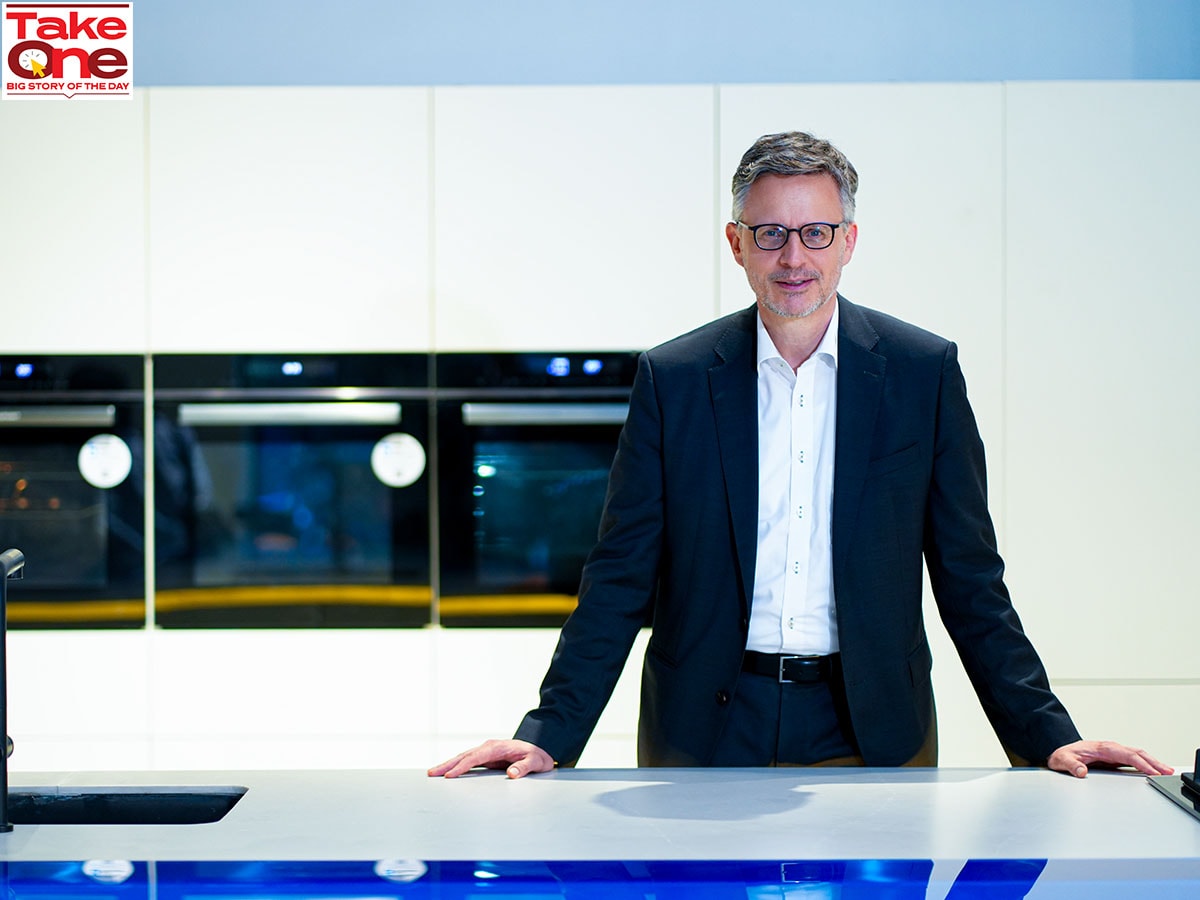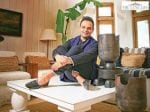- Home
- UpFront
- Take One: Big story of the day
- India has developed from a chaotic place to a 'real' business place: Andreas Hettich
India has developed from a chaotic place to a 'real' business place: Andreas Hettich
The Hettich Group's fourth generation owner talks about how the German home furnishing company survived two world wars, a period of hyperinflation, the separation, and the reunification of Germany, to remain relevant for 136 years, and why it is eyeing India for its next leg of growth

Neha is a versatile financial journalist with experience in leading English business news channels. Her wide-ranging reportage includes impactful undercover investigations, multi-billion dollar deal breaks, and incisive coverage of key corporate and policy developments. She's as comfortable anchoring live news on television, as she is writing insightful columns. She focuses on financial markets and global economy, moderates power-packed panels, and interviews influential industry leaders to get you the latest news, views and analysis of the stories that matter. Also, she curates, hosts and produces Pathbreakers and Money Talks. She holds a postgraduate degree and specialisation certificates in the area of finance from global institutes. When she's not fussing over inflation or balance sheets you may find her on a yoga mat in some beautiful part of the world. But she's always up for good coffee and interesting ideas.
- In hindsight, it would have made sense for us to list in India: Truecaller co-founders
- I had decided I'd never start a family unless a solid investor backs my business: Masaba Gupta
- How and when will AI make money, investors are asking. But is that the real question?
- How Bose Corp is helping Noise to amp up its global market presence
- In no rush to go back to the world of ultra-low interest rates: US Federal Reserve
- Gold vs Equity: Which is a better hedge against global recession?
- Why India isn't a global manufacturing hub
- VCs are traders. They are not investors: Aswath Damodaran
- I don't see Zomato's value dramatically shifting from Rs 35 per share: Aswath Damodaran
- Fall of the Titans: How shoddy corporate governance destroys companies
 Andreas Hettich, Chairman, Hettich Group
Andreas Hettich, Chairman, Hettich Group
Hettich, the 136-year-old German home furnishing company, is bullish about its growth prospects in India. The Kirchlengern-headquartered company, which entered India a decade ago, has invested close to Rs 2,000 crore to expand its manufacturing base in the country, so that it can ‘Make in India for the world’.
Related stories
“We are still the only multinational that has invested significantly in domestic production, which positions us well to handle future competition,” asserts Andreas Hettich, the fourth-generation of the family-owned business.
In an interaction with Forbes India, the Hettich Group chairman, explains what makes India different from other markets, and how he plans to “combine the two worlds; the quality and innovation of Germany, and the creativity and flexibility of India, to give the whole range of offerings to customers”. He also talks about the company’s rich heritage and the legacy he’d want the next generation to carry forward. Edited excerpts:
Q. How has India changed as a business destination for MNCs over the past ten years?
When we first started our business in India, it was quite complicated even to set up the business. I think it took us six months to have a proper internet connection and it was very challenging, from logistics to basically everything. But still we were experiencing good growth at that time.
We built our first manufacturing unit in Vadodara and this was during the time of elections when Prime Minister Modi started his first innings. There was a kind of uncertainty in the country. Let’s say from a macroeconomic point of view, India was not seen that much from the outside world which, over a period of time, has completely changed and turned into a very positive picture. And what I see nowadays is the positive mindset of the people in terms of moving the things forward and thinking big.
We were one of the first to enter the Indian market from a multinational perspective and that was a very good thing because it helped us shape the market by developing customers, furniture, and kitchen industry. So, it was a very great journey. India has developed from a quite chaotic place to a real business place these days.
Q. How have the market dynamics evolved in terms of consumer preferences and spending?
In the beginning, the market was highly unorganised, and, more or less, all our business was through dealers and distributors. There was hardly any mechanised furniture and kitchen production. There are many more developed players entering the market with a very professional setup, and, therefore, it’s changing from traditional handicraft furniture style to modern/modular industrialised kitchen and furniture. So that’s a journey that is still going on. Even though the traditional trades are still in the majority, the demand for organised and modular furniture is rapidly growing.
Q. How do you plan to localise your business model and widen the range of offerings in India?
From the beginning, we started to offer our full range. We have developed mainly in Germany for worldwide assortment, but we decided more than 10 years ago to build our local footprint in terms of development and production. Now, we have a decent production network in India, where we have already built four factories; three in Vadodara and one in Indore and the fifth factory is under construction [and is expected to be operational] by the end of 2025.
Through this vision, we are able to add more local content where we see to it that it always combines with the worldwide offering. We look to combine the two worlds, that is, the quality and innovation of Germany and the creativity and flexibility of India, to give the whole range of offerings to our customers.
Also read: How Ikea's online-first strategy worked in the Indian market
Q. How has Hettich grown in India in the last 10 years?
We have experienced high growth over the last 10 years and it has always been a double-digit growth for sure. Now we are closer to 10 percent but the last 3 years during Covid have been bit bumpy. There have been many ups and downs, but still the tendency is going up and that’s what is driving our market generally. We are a highly integrated company. We start with a raw material and have all processes done in-house. It's quite an investment-heavy business.
Both the number of households and the income level is growing in India compared to most countries. More and more people living in apartments and are looking for modular kitchens and furniture, people are also looking for the better solutions, so we really see a growth in not just the quantity, but also the quality. We see huge potential going forward.
Q. How much have you invested in India so far?
We first invested in the market setup. But the major investment was, for sure, in our production footprint. We have invested more than Rs 2,000 crore already in our four factories, and the fifth factory is one of the bigger ones. This isn’t just a one-time investment; it’s an ongoing process. We’re building the facilities and filling them with machinery, which is worth much more than the buildings themselves.
Our factories are highly automated and we get the best machinery in the world, matching the standards of our factories in Germany. So, we are not working on simple processes here. Factories in India have the same standard as the factories in Germany. This reflects our philosophy: Make in India for the world.
With every new factory, we always start with the domestic market to fill the capacity within the market, and then continuously increase export (to the) surrounding (and global) market. For example, if we deliver our product to the US and China... even though others are doing it the other way around, we produce in India for China. So, there you can see how competitive we are with our production footprint here in India.
Q. What percentage of your total exports are from factories in India?
I can't provide an exact number for our exports because we have a global production setup. I would estimate that about 60-70 percent of our total production is exported, but only around 10 percent comes specifically from India. However, the potential for growth is significant. We're expanding into new product categories and increasing our capacity, so we expect to see more exports from India in the future. This is one of our key growth strategies.
Q. How much does India contribute to global revenue?
It contributes more than 10 percent and it's even getting close to 15 percent of our global business these days. India is the number two market for us. So, Germany is still number one, and then comes India. As India took over China, there’s a bit of a challenge between China and India. But India is still in the lead.
What about competition in this space? Many established global players have entered the market.
As India is showing up more and more on all maps of competitors in the world, everyone has their eyes on India, which is also an advantage for us. As an early mover, we have built a very good set-up. There's enough space for us to grow. As we are the leading brand today, we can even extend our leadership for sure. One big thing, on the lower end of the market, there is a lot of Chinese products coming in. There's not that much local production yet in India, so that is an investment for us. We are still the only multinational that has invested significantly in domestic production, which positions us well to handle future competition.
Q. What is your overall market share in India currently?
So, there’s organised and unorganised market. In the unorganised market, you find products that are imported from China and China is ruling the market, and we are not entering there because this is not what our target group is. So, you can say, approximately 70 percent of the market is still unorganised. And we have the majority share in the remaining 30 percent and this is what makes us the clear market leader.
Q. How is India different from the other countries where you are present?
I always say to my colleagues that, if you wish to experience something special, then go to India, it's really incredible. On the one hand, infrastructure is a challenge compared to other countries, but it has improved a lot over the past 20 years and is still developing. On the other hand, what I always find very impressive are the well-skilled Indian people. The people here are quite well educated, be it in terms of management, salespersons or engineers. They are very eager to grow, to win the markets, and that's very impressive. And when it comes to challenges related to infrastructures, Indians are also highly flexible. That’s very much different from Germans.
Q. What is the legacy that you would want the next generation of Hettich to carry forward?
I took a deep dive into our (Hettich Group) history. It began in Germany in 1888, during a time when it was still a kingdom. We had two world wars, a hyperinflation, and the separation of Germany, reunification, wars, changes, and we survived all of them. Our leading principles is always to adapt to the changes in the way that we are always innovative in products, in production processes, services, and to have a high-quality standard from the beginning.
Some people would say business is so much more difficult these days, but I would disagree. It's different. My father, grandfather, and great-grandfather faced significant challenges. It’s much easier to connect globally now, but for them, it was quite difficult. We started in southern Germany, and our headquarters is now in the North, which was a three-day journey, a hundred years ago. Communication between those two locations, just 600 kmapart, was also challenging. Exporting goods was complicated, but those hurdles have become easier to navigate.
However, we now face global competition and issues like trade wars, such as the one between the US and China. The landscape is constantly changing, and we must adapt while maintaining a positive outlook for the future.
















